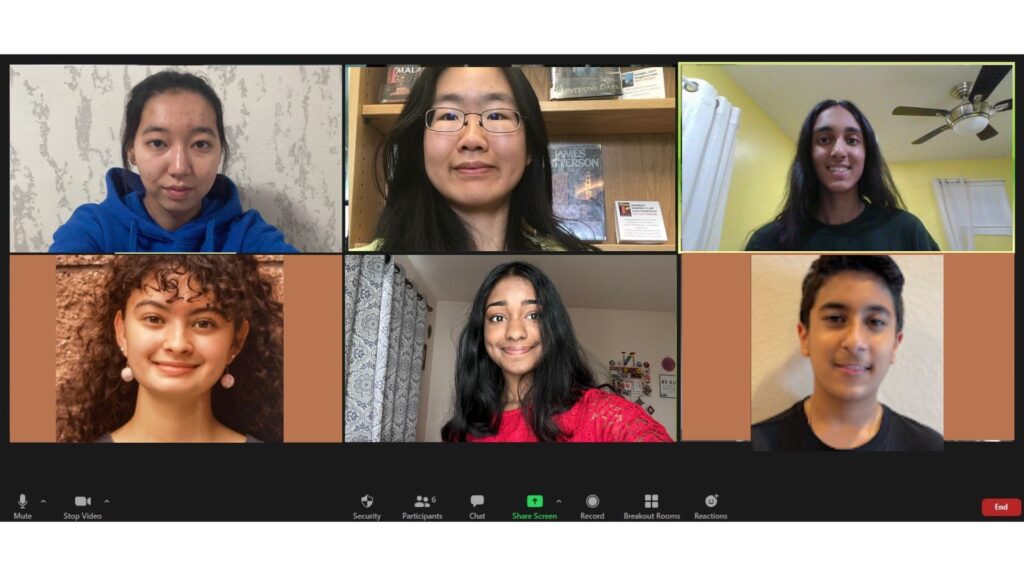Fresh New Methods for Clean Air and Water
Winners of the Junior Academy Innovation Challenge Spring 2023: “Water Sustainability”
Sponsored by the Royal Swedish Academy of Engineering Sciences (IVA)

Team members: Yuanning (Helen) H. (Team Lead) (United States), Aadi M. (United States), Riya K. (United States), Nachammai A. (United States), Sheila M. (United States), Ayazhan K. (Kazakhstan)
Mentor: Kalyani Neti (India)
As climate change continues to threaten water supplies around the world, the ability to access clean water– a right taken for granted by many people in developed countries– is an ongoing struggle for many populations around the world, particularly in tropical regions. According to the World Health Organization, only 53% of medical facilities in these tropical regions have secure, clean water sources. This results in epidemics of cholera (3 million annually) and diarrhea (1.7 billion cases annually).
Additionally, sepsis from dirty water causes 670,000 infant deaths per year. Six enterprising teens from the United States and Kazakhstan heard the call. The formed Cleaners of Warm Water: Air to Water to Healthcare. They won the Spring 2023 Innovation Challenge on Water Sustainability, sponsored by the Royal Swedish Academy of Engineering Sciences (IVA). The team consisted of Yuanning (Helen) H. (United States. Team Lead), Aadi M. (United States), Riya K. (United States), Nachammai A. (United States), Sheila M. (United States), and Ayazhan K. (Kazakhstan). They worked under the guidance of their mentor, Kalyani Neti (India), to devise an ingenious solution for an acute problem. That problem: Lack of access to sterile, medical-grade water, crucial for healthcare in the tropics.

A Broad Range of Skills
The team began their mission, coordinating across time zones to meet online, swapping ideas, and considering various approaches. The multidisciplinary nature of the challenge meant they had to draw on a broad range of skills.
“I got to use knowledge from biology, chemistry, and physics to devise a coherent plan for our prototype and to identify a legitimate target group,” says Team Lead Yuanning (Helen). “I learned so much from all my teammates whose different personal experiences led to their different approaches to problems. For example, I, who lives in the cold and moist Northeast of the United States, would never have come up with the idea of creating sterile water for tropical regions.”
Dividing and Conquering the Workload Across Time Zones
Eventually, the six students decided to develop an affordable air-to-water generator that uses fans to capture humidity in the air (typically between 77% and 88% in tropical countries) and turn it into water. Drawing on their respective strengths, they divided the tasks among the group and created focused roles.
Sheila took on a research-centered role. “I read multiple reports of the World Health Organization and the United Nations in addition to research papers to gain a deeper understanding of the numbers and the types of people affected. I am passionate about global, equitable healthcare, so I was excited to use our water sustainability project to address both the problems of water insecurity and inadequate healthcare.”
Her teammate Ayazhan gathered and organized statistical data on water issues in the tropics. “I searched a lot for statistics and learned that water pollution is a really big problem in tropical regions, justifying it with metric research results,” she explains.
The team members’ intense online sessions soon generated exciting new ideas. “It is a rewarding experience to meet every week, share ideas, plan our solution and work on implementing our idea in the real world,” says Nachammai. “I worked on data confirmation, conducted interviews, and evaluated the results produced through our surveys. I also did research on future collaborations and on ways we could improve our prototype and solution as a team.”
Designing Blueprints — and 3D Models
Their efforts resulted in the development of an affordable 3D prototype of their machine, which can generate 63 liters, (half a bathtub) of water. By trapping groundwater molecules before they get contaminated by germs, parasites or chemicals, the air-to-water generator reduces the need for filtering and delivers small amounts of clean water cheaply, using sustainable energy sources.
Team member Aadi was in charge of designing and developing the blueprints as well as the 3D model. “I also created the simulation where I demonstrated the construction along with the explanation of each part of our prototype,” he says. To complement their air-to-water generator, the students also developed an app that facilitates the maintenance of the machine and enables users to find the nearest source of sustainable hydropower to fuel it.
During the third phase of their project, the students focused on marketing their invention, building a website that details the technology used and touts its benefits to potential users. “Each team member brought with them a different skill set and perspective,” says Riya, who worked on the website design. “I really loved working with a team of dedicated and passionate individuals interested in STEM fields.”
And it doesn’t end there. The team members plan to use 3D printing to turn their model into a functioning and marketable machine, and seek to take their project even further by collaborating with local governments and non-profit organizations in the targeted countries.